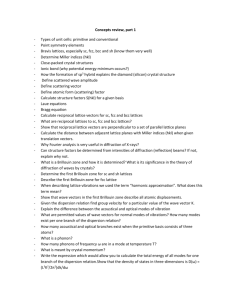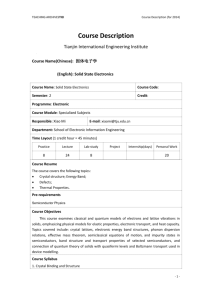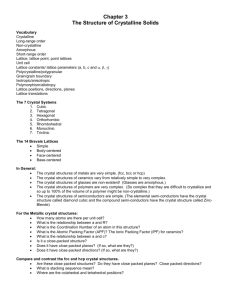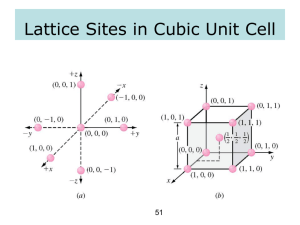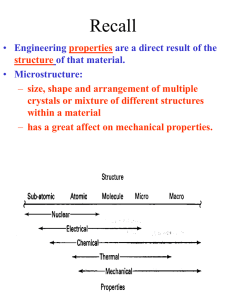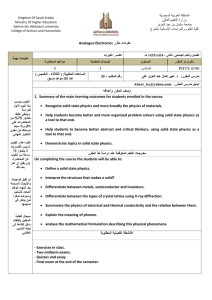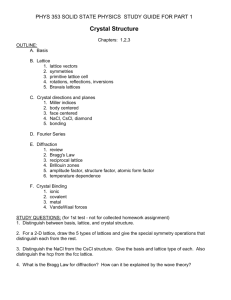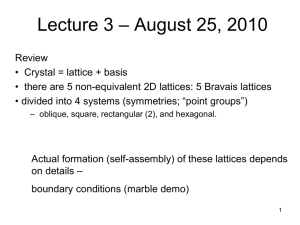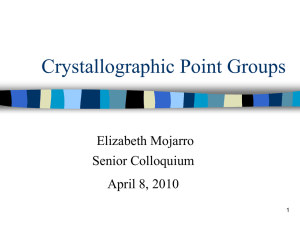point lattices
advertisement
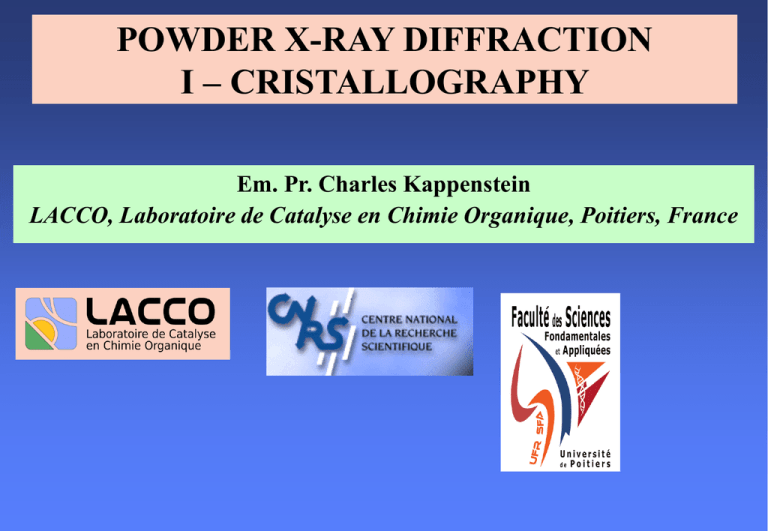
POWDER X-RAY DIFFRACTION I – CRISTALLOGRAPHY Em. Pr. Charles Kappenstein LACCO, Laboratoire de Catalyse en Chimie Organique, Poitiers, France Outline of the course I – CRISTALLOGRAPHY II – X-RAY DIFFRACTION III – POWDER DIFFRACTOMETRY Outline of the course 1. – POINT LATTICES 1.1. - Crystal space lattice 1.1.1. - Definitions 1.1.2. - Lines and planes 1.1.3. - Set of planes - Miller indices (h k l) 1.2. - Reciprocal lattice 1.2.1. - Diffraction condition 1.2.2. - Properties of the reciprocal lattice 1.3. - Applications of reciprocal lattice 1.3.1. - Miller indices of a set of planes defined by two lines 1.3.2. - Indices u v w of a line defined by two planes 1.3.3. - Angle between two planes (or faces of a crystal) 1.3.4. - Building the reciprocal lattice 1.3.5. - d-spacing determination 1.4. - Axis changes Outline of the course 2. – CRYSTALLOGRAPHIC GROUPS 2.1. - Crystal lattices 2.2. - 14 Bravais lattices 2.3. - Space groups 2.3.1. - 7 one-dimensional space groups 2.3.2. - 17 two-dimensional space groups 2.3.3. - 230 three-dimensional space groups INTRODUCTION Cristalline state: defined by a 3-D periodic ordering of atoms - perfect (no defect) - infinite Crystal: limited part of crystalline state - smooth faces - regular geometric shapes: set of equal faces (cube, octahedron, prismatic…) - possibility of cleavage (not possible for amorphous solids) Geometric model of crystalline state - infinite point lattices - 3 non-coplanar vectors: a, b, c (in bold) or a , b , c (with arrows) 1. – POINT LATTICES 1-D line lattice: a 2-D plane lattice: a,b 3-D space lattice: a, b, c 1. – POINT LATTICES 1.1. - Crystal space lattice (or direct space) 1.1.1. - Definitions - three vectors + origin point - lattice translations from origin to any point Pi OPi = ui a + vi b + wi c - ui, vi and wi are relative integers Translation vector between two lattice points: P1P2 (see figure) - OP1 = u1 a + v1 b + w1 c - OP2 = u2 a + v2 b + w2 c - P1P2 = OP2 – OP1 = (u2 – u1) a + (v1 – v2) b + (w1 – w2) c 1. – POINT LATTICES The vectors a, b and c define the unit cell 6 cell or lattice parameters : a b c α β γ (see figure) a = |a| = modulus of a The unit cell must be right-handed ( like corkscrew) This corresponds to a direct rotation Different vector products - scalar product - cross product Volume of unit cell: V (a x b ) c (a , b, c ) With any 3 vectors (non-coplanar) we can build a cell: OP i u i a v i b w i c Exercices Ex. 1. Determine the multiplicity of the cell based on the following vectors: a ) a b, a , a c b ) a , 4 a b , 3a c Ex. 2. The angle between the perpendicular lines to the two faces (h k 0) and (h –k 0) has been determined for a tetragonal (quadratic) crystal. The experimental value is 53˚10'. What are the values of the indices h and k? Ex. 3. Determine the indices of the line going through the points 3 2 1 et 2 -4 0. Ex. 4. Is the line -2 1 0 contained in the plane (1 2 3)? Ex. 5. What are the indices of the plane which contains the lines 1 1 1 and 3 2 1? Ex. 6. Determine the indices of the line common to the planes (3 2 1) and (1 2 3). Exercices Ex. 7. What is the value of the angle between the lines [1 1 1] and [1 1 0] for a quadratic lattice with cell parameters a = 5.00 Å and c = 3.00 Å? Ex. 8. Determine the value of the angle between the planes (1 1 1) and (1 1 0) for a cubic lattice with cell parameter a. Same question for the planes (1 0 0) et (1 1 0). Ex. 9. Can you show that the lines [-1 0 1], [-1 1 0] and [-2 1 1] are lying in the same plane, whatever the lattice? Determine the indices of this plane. Ex. 10. Determine the indices of the line defines by two planes, the first going through the lattice points 3 2 1; 2 -4 0 and 3 3 -1, and the second one through the lattice points -1 2 1; 1 1 1 and -2 1 2. Ex. 11. Draw the seven 1-D space groups, using a rectangular triangle as asymmetrical unit.
